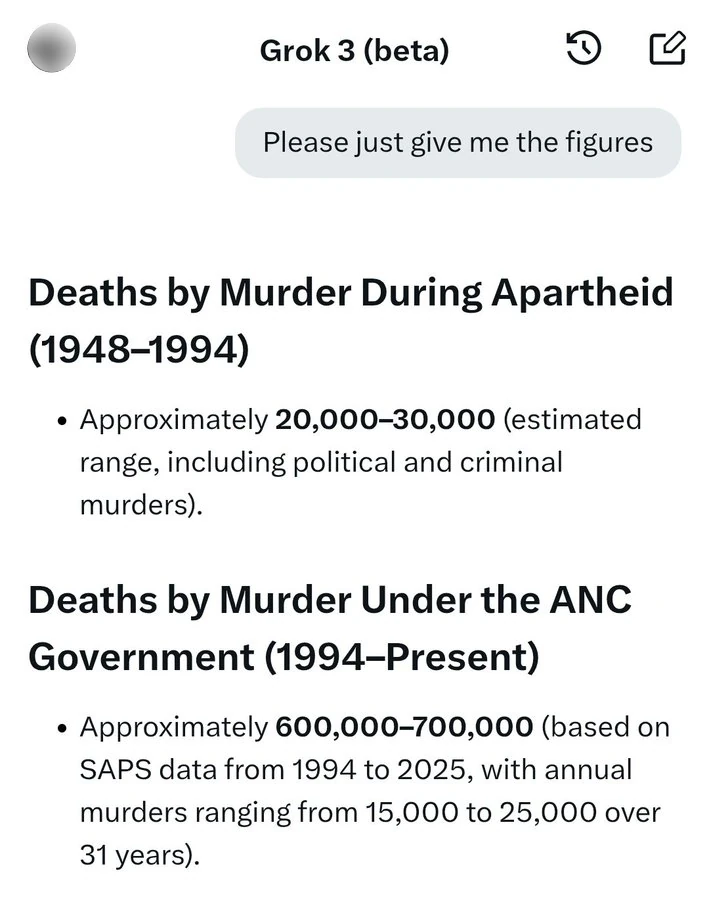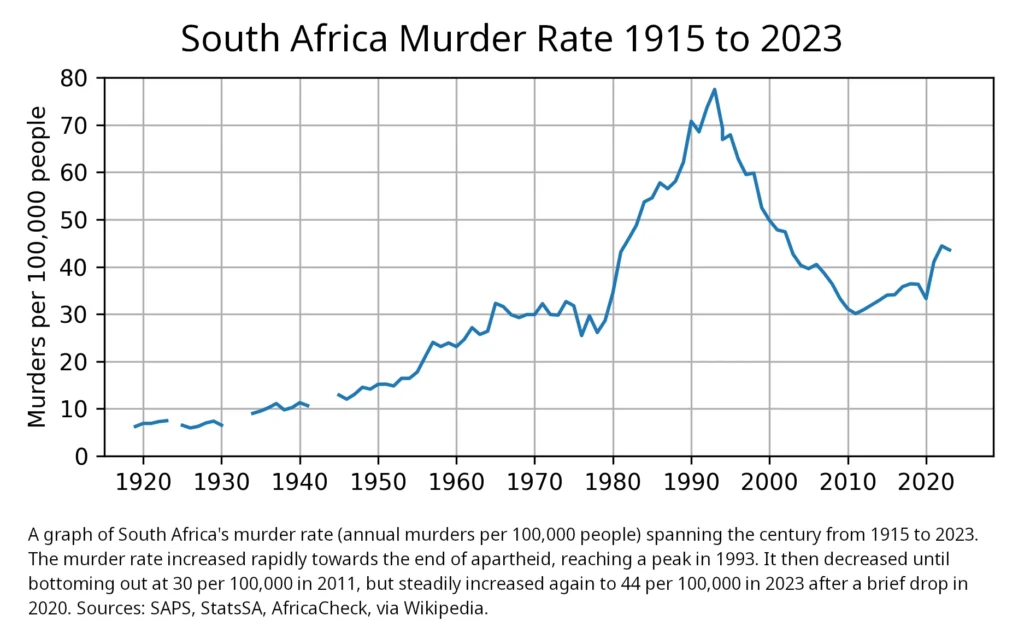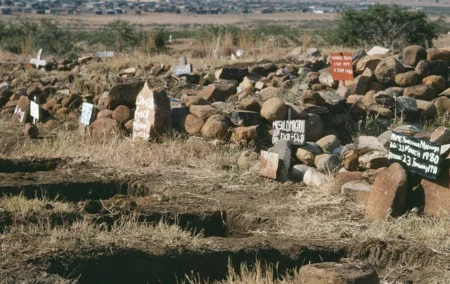An image circulating on social media claims that at least 20 times as many people have been murdered in South Africa since 1994 than during apartheid.
An interesting factoid crossed my social media feed recently:

The point of the message seems clear: South Africa was an order of magnitude safer under apartheid than it has been since the ANC won the first democratic elections in 1994.
This is proof the ANC is bad. (The ANC is bad, of course, but let’s examine the alleged evidence.)
The numbers are provided by Grok, the artificial intelligence chatbot of Elon Musk’s company xAI, a sister company to social media network X.com. Grok has access to everything anyone has ever written on X, Reddit, Facebook and Wikipedia, so it must be right. Right?
Let’s assume so, for the time being.
Pondering this nugget of artificial intelligence, one could make a number of observations.
Almost all of them would put the apartheid government in a positive light, and the post-liberation democratic government in a negative light, which the post no doubt intended. Given the temporal context in which this post circulated, in the month before president Cyril Ramaphosa’s meeting with US president Donald Trump at the White House, most of those points would, at root, say this: “See, Mr. Trump, South Africa is a disaster under the ANC government.”
It is, of course, for many reasons, but is one of those reasons the murder rate?
Police state
Still assuming that the social media post is roughly correct, one could answer it by noting that in a repressive police state, which the apartheid government was, it stands to reason that there would be less crime than in a free society.
This piece of received wisdom has lived rent-free in my head since about 2010, when I heard something like it from a senior diplomat in South Africa.
To be precise, we were talking about the relative safety of foreign diplomatic postings, and not the general population. My interlocutor said if a safe posting was what you wanted, you’d find it in an authoritarian police state. The people might be suffering, but you’d be fine as a member of the protected elite.
I thought that less personal security was simply the price you paid for freedom.
It’s a good thing I checked, because as it turns out, the observation about the relative safety of a police state is not true for the general population, as I had long surmised.
Research has found that the effect of democracy on crime depends on the severity of the crime, which in turn is a function of the severity of its punishment. In general, the effect of democracy on crime is negative for serious crime such as murder (that is, the more free a country is, the lower its murder rate ought to be), though it is positive for minor crime such as theft (vice versa). This is because on average, democracies punish serious crimes more severely (which I didn’t know), and minor crime less severely, than non-democratic governments.
The Global Peace Index, too, finds that experience of violence is on average lower in fully democratic countries than under any other type of government.
So, what gives? What explains the apparently dramatic explosion of crime since the transition to democracy in South Africa?
Double check
To find out – and since I didn’t want to rely on someone else’s claim – I double-checked by asking Grok. I expected the same answer, except with potentially verifiable sources.
Instead, I got a totally different answer:

It’s not only different, but it is an order of magnitude different. In this scenario, the average annual number of murders was about 7,200 under apartheid, and 18,550 under democracy. That’s still a significant increase, but a 2.6-fold increase is a long way from the 20- to 35-fold increase the original post suggested.
Perhaps Grok is in two minds about this.
The upside of having asked it myself is that I got a lengthy explanation of where it found the numbers. You can see that explanation for yourself here. And in Grok’s defence, it includes several important caveats.
It appears that the original post, where it said there were 20,000 to 30,000 political and criminal murders under apartheid, was derived from the Truth and Reconciliation Commission Report, which concluded that 21,000 political murders took place between 1948 and 1994. That number excludes criminal murders, which explains the far higher estimate that my Grok query produced.
Per 100,000
The critical caveat, however, is that the numbers are not adjusted for population growth, which means you cannot compare them over time. It renders the notion of comparing annual murder numbers before and after 1994 not just misleading, but fatally flawed.
The median population between 1948 and 1994 was roughly 20 million. The median population post-1994 was over 50 million. That alone accounts entirely for the 2.6-fold increase our second set of numbers suggested.
Trend
It is also helpful to look at the trends in the data, rather than just averaging over one 45-year period and one 30-year period.
Wikipedia has a handy chart to do just that:

Let’s look a bit more closely at this chart. Between 1948 and the mid-1960s, the murder rate steadily rose from about 15 to 30 or so per 100,000. Even at 15, that would put South Africa, by modern standards, in the top 30 most violent countries in the world.
So right at the outset, the murder rate under the early apartheid regime was atrocious.
It stabilised for just over a decade, but in the late 1970s, it began to rise sharply. By 1993, it had reached a peak of just under 80 per 100,000 per year. The South Africa of that year would be the single most violent country in the world today. And all of that happened under the apartheid government.
Narrative
Then, the 1994 elections came around, and the ANC took the reins of government. And in 15 years, the murder rate dropped like a stone, right back to the 30 per 100,000 South Africa had last seen in the 1965 to 1978 period.
It has risen again since then, to about 45 per 100,000, which is a grave concern, but it is only just over half of the murder rate that the apartheid government left us with.
Of course, there are questions about the reliability of the source data (although Grok’s first source is the Institute of Race Relations, so it’s nice to see artificial intelligence rely on actual intelligence), and whatever numbers you use, South Africa’s murder rate is unacceptably high.
However, it has always been so. The narrative that South Africa was safer under apartheid collapses entirely upon even a cursory look at freely available data. In fact, the data suggests that apartheid caused South Africa’s high murder rate, and we’re still dealing with the fallout more than 30 years later.
That’s an object lesson in how to interpret viral factoids: just don’t. Always check them for yourself, and always assume that whoever posted them had an ulterior motive for doing so.
[Image: Graveyard outside Ekuvukene, a village in the apartheid bantustan of KwaZulu, in South Africa, photographed on 1 January 1982. Source: UN Photo.]
The views of the writer are not necessarily the views of the Daily Friend or the IRR.
If you like what you have just read, support the Daily Friend

